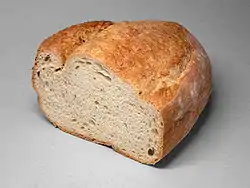Okonomiyaki
Okonomiyaki (お好み焼き, o-konomi-yaki) (![]() listen ) is a Japanese savory dish containing a variety of ingredients in a wheat-flour-based batter; it is an example of konamon (flour-based Japanese cuisine). The name is derived from the word okonomi, meaning "how you like" or "what you like", and yaki meaning "cooked" (usually fried). Okonomiyaki is mainly associated with the Kansai or Hiroshima areas of Japan, but is widely available throughout the country. Toppings and batters tend to vary according to region. In Tokyo, there is a semi-liquid okonomiyaki called monjayaki.
listen ) is a Japanese savory dish containing a variety of ingredients in a wheat-flour-based batter; it is an example of konamon (flour-based Japanese cuisine). The name is derived from the word okonomi, meaning "how you like" or "what you like", and yaki meaning "cooked" (usually fried). Okonomiyaki is mainly associated with the Kansai or Hiroshima areas of Japan, but is widely available throughout the country. Toppings and batters tend to vary according to region. In Tokyo, there is a semi-liquid okonomiyaki called monjayaki.
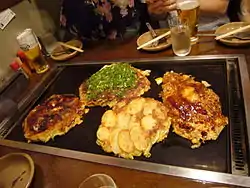 Various types of okonomiyaki | |
| Course | Main course |
|---|---|
| Place of origin | Japan |
| Region or state | Japanese-speaking areas |
| Main ingredients | Cabbage |
| Variations | Regional variations |
.jpg.webp)
Kansai area
Kansai- or Osaka-style okonomiyaki is the predominant version of the dish, found throughout most of Japan. The batter is made of flour, grated nagaimo (a long type of yam), water or dashi, eggs and shredded cabbage, and usually contains other ingredients such as green onion, meat (usually thinly sliced pork belly or American bacon), octopus, squid, shrimp, vegetables, konjac, mochi or cheese. Okonomiyaki is sometimes compared to an omelette or a pancake and may be referred to as a "Japanese pizza" or "Osaka soul food".[1]
Some okonomiyaki restaurants are grill-it-yourself establishments, where the server produces a bowl of raw ingredients that the customer mixes and grills at tables fitted with teppan, or special hotplates. They may also have a diner-style counter where the cook prepares the dish in front of the customers.
In Osaka (the largest city in the Kansai region or West Japan), where this dish is said to have originated, okonomiyaki is prepared much like a pancake. The batter and other ingredients are pan-fried on both sides on either a teppan or a pan using metal spatulas that are later used to cut the dish when it has finished cooking. Cooked okonomiyaki is topped with ingredients that include otafuku okonomiyaki sauce (similar to Worcestershire sauce but thicker and sweeter), aonori (seaweed flakes), katsuobushi (bonito flakes), Japanese mayonnaise, and pickled ginger (beni shōga).
Variants
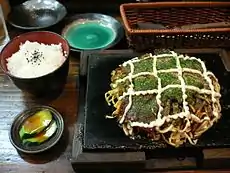

When served with a layer of fried noodles (either yakisoba or udon), the resulting dish is called modan-yaki (モダン焼き), the name of which may be derived from the English word "modern" or as a contraction of mori dakusan (盛りだくさん), meaning "a lot" or "piled high" signifying the volume of food from having both noodles and okonomiyaki.
Negiyaki (ねぎ焼き) is a thinner variation of okonomiyaki made with a great deal of scallions, comparable to Korean pajeon and Chinese green onion pancakes.
Hiroshima area
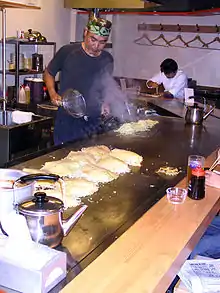
In Hiroshima, the ingredients are layered rather than mixed. The layers are typically batter, cabbage, pork, and optional items such as squid, octopus, and cheese. Noodles (yakisoba, udon) are also used as a topping with fried egg and a generous amount of okonomiyaki sauce.
The amount of cabbage used is usually three to four times the amount used in the Osaka style. It starts out piled very high and is pushed down as the cabbage cooks. The order of the layers may vary slightly depending on the chef's style and preference, and ingredients vary depending on the preference of the customer. This style is also called Hiroshima-yaki or Hiroshima-okonomi.
Okonomi-mura, in Naka-ku in Hiroshima, was the top food theme park destination for families in Japan according to an April 2004 poll.[2][3]
Other areas
- Tsukishima district in Tokyo is popular for both okonomiyaki and monjayaki. Monjayaki is a liquid, runny variant of okonomiyaki. The main street of this town is called "Monja Street".[4]
- In Hamamatsu, takuan (pickled daikon) is mixed in okonomiyaki.
- In some areas of Kyoto city, an old style okonomiyaki called Betayaki (べた焼き) is served. The dish is prepared in layers of thin batter, shredded cabbage and meat, with a fried egg and noodles.[5]
- In Okinawa, okonomiyaki is called hirayachi (ヒラヤーチー) and is thinner than in other areas. People cook it at home, so there are few okonomiyaki restaurants in Okinawa, with none of them serving hirayachi.[6]
- In Hinase, Okayama, oysters (kaki) are mixed in okonomi-yaki, to make kaki-oko.
- In Kishiwada, Osaka, a variation of okonomiyaki called kashimin-yaki is made of chicken and tallow instead of pork.
- In Fuchū, Hiroshima, fuchuyaki is made with ground meat instead of pork belly.
- In Tokushima Prefecture,stewed sweet kintoki-mame is mixed in okonomiyaki.
History
Food researcher Tekishū Motoyama has pointed out that a sort of thin crepe-like confection called funoyaki (麩の焼き)[7] may be an early precursor, though it hardly includes the bare elements that makes it identifiable as okonomiyaki. Records of the word funoyaki occur as far back as the 16th century, and Sen no Rikyū writes about it,[8] but what it really was can only be speculated, and may have involved the use of fu (wheat gluten), though certainly by the late Edo period,[9] funoyaki referred to a thin crepe baked on a cooking pot, with miso basted on one side.[7][8]
This, Motoyama writes, was modified into a form using nerian (練り餡) (sweet bean paste)[7] and came to be called gintsuba (銀つば) in Kyoto and Osaka, then moved to Edo (Tokyo) where it was named kintsuba (金つば),[7] of which Sukesōyaki (助惚焼), a specialty of Kōjimachi, was one variant.[7]
In the Meiji Era, the confection was taken up by the dagashiya (駄菓子屋, "informal confection shop") trade, which called it mojiyaki (文字焼き). After the 1923 Great Kantō earthquake when people lacked amenities it became sort of a pastime to cook these crepes.[7] This fad gained great popularity, and soon, besides the sweet types, savory types using fish, vegetables, and various meat began appearing.[7]
A simpler version of okonomiyaki, made with readily available ingredients, became popular in Japan during World War II when there was a short supply of rice. The wheat pancake was nutritious, filling, and inexpensive and was often served as a snack to children.
The issen yōshoku (一銭洋食, "1-sen Western food") of Kyoto, started around the Taishō era may have been the primitive form of okonomiyaki, as it uses Worcestershire sauce and chopped scallion.[10]
Outside of Japan
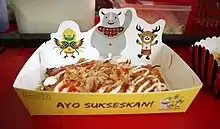
Okonomiyaki and takoyaki are popular street fare in Manila, Taipei, Bangkok, and Jakarta.[11]
See also
| Wikibooks Cookbook has a recipe/module on |
- Hirayachi – Okinawa
- Japanese cuisine – Culinary traditions of Japan
- Jeon – Korean pan-fried dish
- Monjayaki
- Okoy
- Omakase – Japanese restaurant order
- Pajeon – Korean pan-fried scallion dish
- Pannenkoek
- Takoyaki – Japanese appetizer
- Teppanyaki – Post–World War II style of Japanese cuisine that uses an iron griddle to cook food
- Bánh xèo – Vietnamese stuffed pancake
- Bindaetteok
- Egg foo young
- Tunisian tajine
- Spanish omelette – Traditional Spanish dish of egg and potato
- Frittata – Egg-based Italian dish
References
- 99japan
- 「お好み村」が家族で行ってみたいフードテーマパークで1位に! ["Okonomi-mura" the #1 food theme park families want to visit!] (in Japanese). Hiroshima Home Television. May 3, 2004. Archived from the original on July 21, 2011.
- 牛田泰正 (Yasumasa Uchida) (Spring 2007). 観光地における飲食業 [The food and drink industry in sightseeing areas] (PDF) (in Japanese). p. 50. Archived from the original (PDF) on July 27, 2011. Retrieved December 11, 2010.
- Food for Thought Okonomiyaki vs. Monjayaki!
- "Donguri Okonomiyaki Dining in Kyoto, Japan: Okonomiyaki vs Betayaki vs Negiyaki". The Poor Traveller. Retrieved 7 November 2020.
- "Archived copy". Archived from the original on 2015-05-03. Retrieved 2014-09-22.CS1 maint: archived copy as title (link)
- Heibonsha 1964 encyclopedia vol. 3, p.445, article on okonomiyaki by Tekishū Motoyama 本山荻舟 (1881-1958)
- Kumakura 2007, p.168
- In Heibonsha 1964 funoyaki is (mistakenly) said to be a late Edo-period confection
- Ono, Fujiko (小野藤子) (2009). おうちで作る鄉土ごはん. 枻出版社. ISBN 9784777914449., p.95
- Media, Kompas Cyber (2011-02-10). "Okonomiyaki Merambah Kaki Lima - Kompas.com". KOMPAS.com (in Indonesian). Retrieved 2018-09-15.
Bibliography
- Heibonsha (1964). 世界百科事典 (Sekai hyakka jiten). (World Encyclopedia, in Japanese).
- Kumakura, Isao (熊倉功夫) (2007). Nihon ryori no rekishi (日本料理の歴史). Yoshikawa Kobunkan (吉川弘文館).
External links
| Wikimedia Commons has media related to Okonomiyaki. |
- What is Okonomiyaki? - Okonomiyaki, an Overview. The history of Okonomiyaki and Okonomiyaki sauce in Hiroshima.
- "As-you-like-it Pancake" – Okonomiyaki; what it is, how to cook it, and a sample recipe.
- Okonomiyaki: a recipe from Japan - Okonomiyaki explanation and gluten-free sample recipe.
